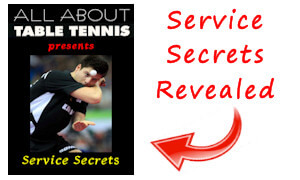You Are Here: Home » Rules of Table Tennis » Yellow Cards and Red Cards
Yellow Cards and Red Cards
Yellow cards and red cards are a recent addition to the game of table tennis.
But what do they mean? Find out here.
By Martin Hughes
Owner and Editor
GREAT GIFTS
Portable Table Tennis Table...
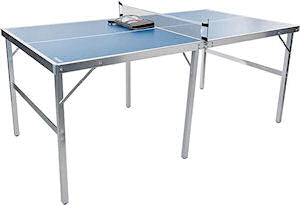
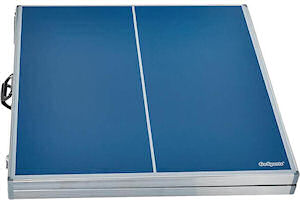
Table Tennis Net, Rackets, Ball and Case...

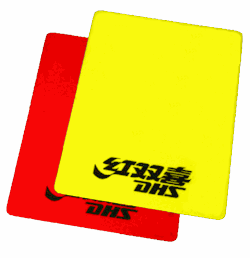
Yellow and red cards were first introduced into the game of table tennis in 1991.
But what do they mean?
And what do the rules and regulations say about them?
Let's take a closer look.
Note: White cards are used to signal "Time-outs" in a match. You can read about them here.
TABLE TENNIS EXPERT
REVEALS HIS SECRETS
Click Here For Details

Click here for a large selection of
table tennis equipment at Megaspin *

Click here for a large selection of
table tennis equipment at Bribar *
IMPORTANT NOTE
Before we go any further, it's worth noting the difference between the Laws (commonly referred to as the rules) of the game and the Regulations.
The Laws are the "basic" rules of the game and are mandatory for all sanctioned table tennis events, whereas the Regulations are supplementary to the Laws and are only mandatory for ITTF (International) events.
However, the Regulations may also be used for non ITTF events and it is for the event organiser to decide whether they will use any or all of the Regulations.
So, depending on the competition you are playing in, the Regulations may or may not apply. But as a general rule, the higher the level of competition, the more likely it is that some or all of the Regulations will be used in addition to the basic Laws.
Need your questions about the Rules and Regulations answered SIMPLY and CLEARLY?
Take a look at this fully up-to-date downloadable book. You'll find everything you need.
Get all the details here...
TABLE TENNIS EXPERT
REVEALS HIS SECRETS
Click Here For Details

Click here for a large selection of
table tennis equipment at Megaspin *

Click here for a large selection of
table tennis equipment at Bribar *
^ Top of page ^
So let's take a look at what the rules of table tennis say about...
Yellow and Red Cards
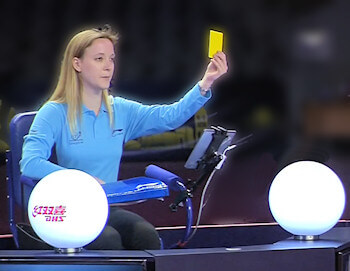
The use of yellow and red cards are not included within the Laws of the game, but are contained within the additional Regulations, so they'll only be used in events which use these regulations.
So what are they for?
Well, yellow and red cards are shown by umpires and referees to players and coaches (and advisers in team matches) who break the rules or misbehave during the course of a match or a tournament.
But what is "misbehaviour"?
Well, as you can imagine, it would be very difficult to define exactly what constitutes misbehaviour in written form, so setting and applying acceptable standards of behaviour by players and coaches is more a matter of judgment and common sense.
Fortunately, table tennis doesn't have a history of poor behaviour but a small minority of players and coaches could cause problems, so yellow and red cards have been introduced.
^ Top of page ^
So let's take a look at the regulation which deals with...
Discipline
Regulation 3.05 covers the area of discipline in table tennis, and it applies to both players and coaches.
Coaches giving advice
 by courtesy of the ITTF
by courtesy of the ITTF
The first part of this regulation deals with coaches giving advice to players.
This Regulation was amended with effect from 1 October 2016.
Previously, advice was only allowed to be given by a coach during the intervals between games or during other authorised suspensions of play. But with effect from 1 October 2016 players may now receive advice at any time, except during rallies, provided that continuity of play is not affected.
If these Regulations are contravened, the umpire will hold up a yellow card and warn the coach that any further offence will result in dismissal from the playing area.
If the coach again gives advice illegally during the same match, after a yellow card has been shown, the umpire will hold up a red card and send the coach away from the playing area until the individual match has ended.
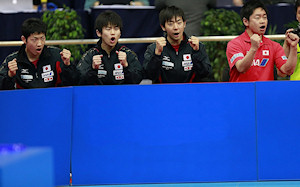 by courtesy of the ITTF
by courtesy of the ITTF
If this happens during a team match, and ANY authorised person (usually the other players in the team) gives advice to the player after a yellow card has been shown, the umpire will hold up a red card and send that person away from the playing area, whether or not they were the person previously warned.
In a team match, the dismissed adviser is not allowed to return, except when required to play, and cannot be replaced by another adviser until the team match has ended.
Misbehaviour
The second part of this regulation deals with misbehaviour.
Players and coaches can also be shown yellow cards for misbehaviour.
The regulation states that players and coaches must refrain from behaviour which may unfairly affect an opponent, offend spectators or bring the sport into disrepute.
Examples of this are - abusive language, deliberately breaking the ball or hitting it out of the playing area, kicking the table or surrounds and disrespect of match officials.
Yellow cards are designed for less serious offences but if a player or coach commits a serious offence, the umpire must suspend play and report it immediately to the referee.
However, for less serious offences the umpire may, on the first occasion, hold up a yellow card and warn the offender that any further offence is liable to incur penalties.
If the player then commits a second offence in the same individual match or team match, the umpire will award 1 point to the offender's opponent. And for a third offence he will award 2 points, each time holding up a yellow and a red card together.
If a player continues to misbehave after three offences in the same individual match or team match, the umpire will suspend play and report it immediately to the referee.
If the coach continues to misbehave after receiving a yellow card, the umpire will hold up a red card and send the coach away from the playing area.
Doubles
In doubles, a warning or penalty incurred by either player of a doubles pair will apply to the pair, but not to the non-offending player in a subsequent individual match of the same team match.
^ Top of page ^
So what do the regulations say about...
Time limits for yellow cards
Yellow cards remain in force for the duration of an individual match or, in a team event, the remainder of the team match.
After a yellow card has been shown to a player, a yellow marker is placed near the scoreboard, next to the score of the player who has been warned.
If a second yellow card is then shown to the same player, both a yellow and red marker are placed near the scoreboard.
These markers will remain near the scoreboard for the duration of that players' individual match, and in a team match, are carried over to that players' subsequent individual matches.
Once a yellow card has been shown, subsequent offences must automatically be penalised by the award of points to the opponent. An umpire cannot issue further warnings without penalty points.
However, penalty points may sometimes be awarded after a game has ended, or 2 penalty points might be awarded against a player when his opponent needs only 1 point to win the game.
If the match has not ended, any "unused" points are transferred to the next game of that individual match, so that it starts at the score of 0-1 or 0-2 in favour of the offender's opponent, but if the match has ended they should be ignored.
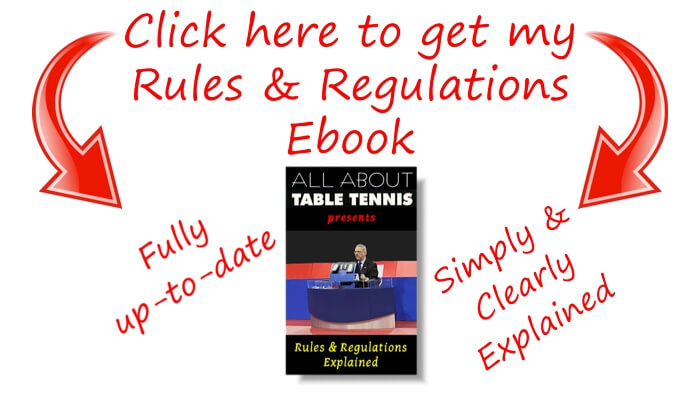
^ Top of page ^
But what about...
Doubles
In a team match, a doubles pair carry forward any warnings or penalties incurred in their previous singles matches AND, as a doubles pair, are regarded as having incurred the higher of any warnings or penalties incurred by either of the players in those singles matches.
So, if one player has been warned in a previous match (1 yellow card), and the other player had incurred 1 penalty point (2 yellow cards), a first offence by either of them in the doubles match would incur 2 penalty points (the penalty for 3 yellow cards).
A warning or penalty during a doubles match applies to the pair during that match, but only the offending player will carry it over to a subsequent individual match.
The following example illustrates this point...
In a team match with 4 singles and 1 doubles matches, players A & B are paired to play the doubles match.
In their first singles matches in this team match, A was warned (1 yellow card) and B incurred a penalty point (2 yellow cards).
In the 2nd game of the doubles match, A intentionally breaks the ball by stepping on it.
The umpire awards 2 penalty points against A/B (the penalty for 3 yellow cards).
In their next singles matches, each player carries forward 1 penalty point.
In a team match the umpire must record warnings and penalties on the score sheet so that they can be transferred to later matches, but umpires should also do the same for individual events.
This will allow the referee to take account of persistent bad behaviour when deciding, for example, whether to disqualify a player.
^ Top of page ^
And what do the regulations say about...
Red Cards for players and coaches
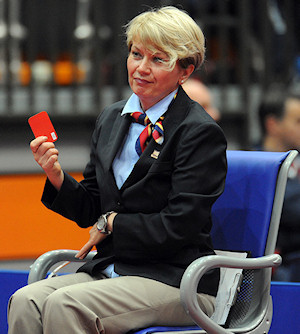 by courtesy of the ITTF
by courtesy of the ITTF
The referee has the power to disqualify a player from a match, an event or a whole competition, for seriously unfair or offensive behaviour, whether it was reported to him by the umpire or not. He does this by holding up a red card.
If a player is disqualified from 2 matches of a team or individual event he will automatically be disqualified from that team event or individual competition.
If a player is disqualified from a match, event or competition for any reason, he will automatically forfeit any associated title, medal, prize money or ranking points.
The umpire can also issue a red card to coaches (and advisers in a team match).
^ Top of page ^
But there is also room for...
Discretion by the Referee
The referee may, however, use discretion in deciding whether to disqualify a player from a match, an event or a whole competition, according to the gravity of the offence.
But there are certain offences for which disqualification is mandatory and others for which it is the usual procedure.
However, the disciplinary powers of the referee and the competition management committee do not normally extend beyond the competition for which they are appointed and any subsequent penalties can only be decided by the offender's National Association.
Where there has been a serious breach of the disciplinary regulations for which a player or coach has been disqualified, the referee must prepare a report for the host Association to send to the offender's National Association.
Need your questions about the Rules and Regulations answered SIMPLY and CLEARLY?
Take a look at this fully up-to-date downloadable book. You'll find everything you need.
Get all the details here...
Note: White Cards
White cards are used to signal "Time-outs" in a match. You can read about them here.

^ Top of page ^
| MORE PAGES ABOUT THE RULES OF TABLE TENNIS |
|---|
For more information about the rules of table tennis, take a look at my other articles which explain the Official
Laws of Table Tennis and the additional Regulations (for higher level play) in more detail...
The Laws of Table Tennis
Regulations (for higher level play)
General
Frequently Asked Questions
|
Click here for a large selection of
table tennis equipment at Megaspin *

Click here for a large selection of
table tennis equipment at Bribar *
^ Top of page ^
You Are Here: Home » Rules of Table Tennis » Yellow Cards and Red Cards
